Two new submissions inspired me to revive this post from 2008.
Part of the privilege of being white is having a society that considers you the norm and is, therefore, organized around you. A really nice example of this is “flesh” color. What is flesh color?
Ben O. sent us this 1952 ad for bandaids (from Vintage Ads)
The next set of images come from Nathan Gibbs’ flickr photostream:
A lot of companies have gotten a clue. Crayola doesn’t have flesh color anymore (or so I’ve heard, let me know if I’m wrong). And now they make “multicultural crayons.” Though, Nathan notes:
It’s interesting how “culture” here is a substitute for “race.”
“White” skin is still taken-for-granted in many products. Here are a couple examples I’ve collected (found here and here):
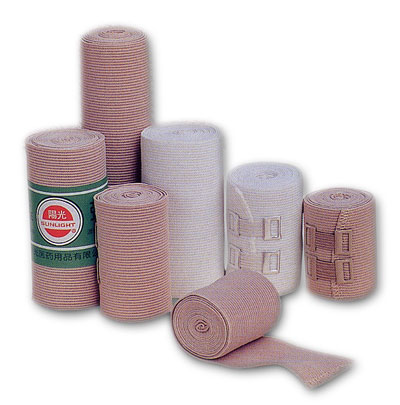
Perhaps trying to walk the line, EcoPencil has a “light flesh” color, but no other flesh colors to choose from (sent in by kelebek in Australia):
Caroline observed that Breathe Right not only centers whiteness in their logo…
…but calls white skin “normal” (see second-to-bottom line):
For more examples, see our posts on (the irony of) Michelle Obama’s champagne-colored described as “flesh-colored”, the widespread use of such language to describe light tan in the fashion world, and lotion marketed as for “normal to darker skin.” See also our Contexts essay on race and “nude” as a color.
For contrast, see this post about how the generic human in Russian cartoons is colored black instead of white.
Lisa Wade, PhD is an Associate Professor at Tulane University. She is the author of American Hookup, a book about college sexual culture; a textbook about gender; and a forthcoming introductory text: Terrible Magnificent Sociology. You can follow her on Twitter and Instagram.
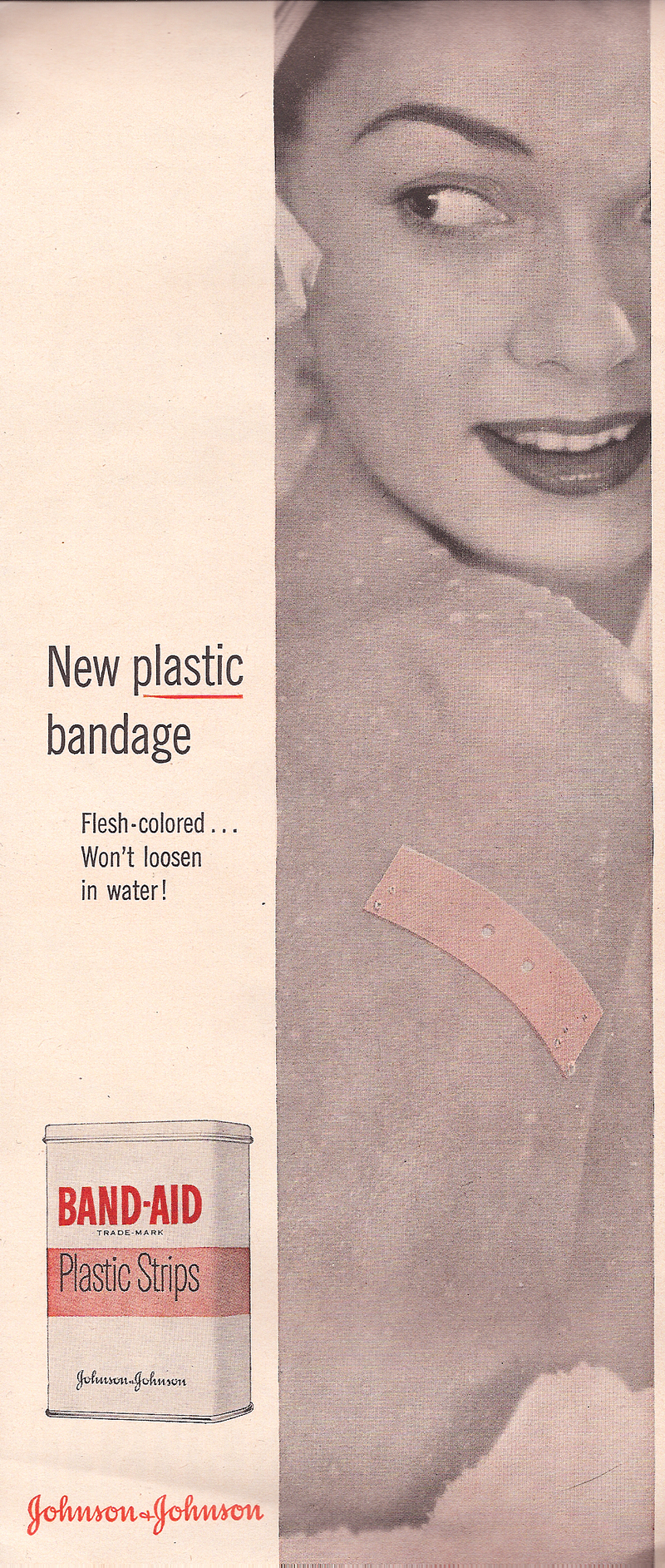
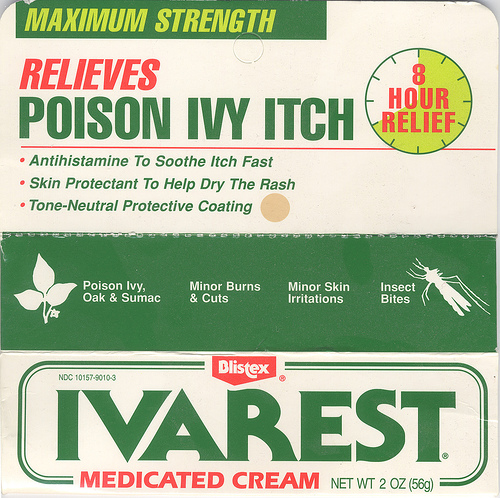
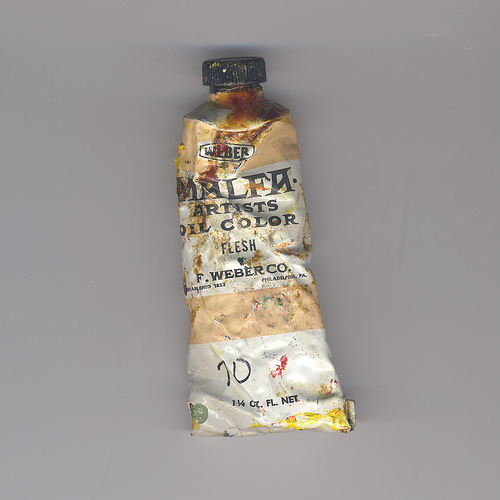
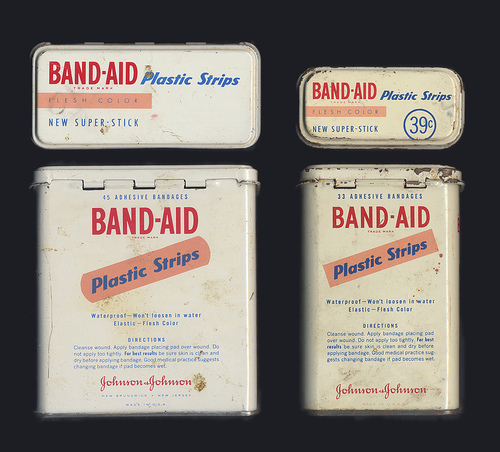
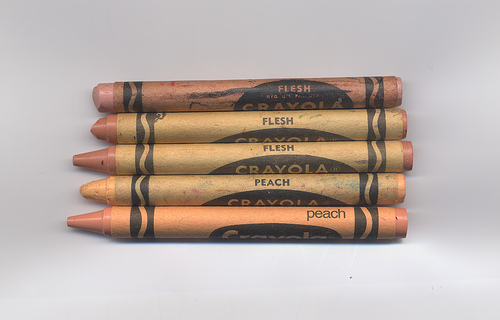
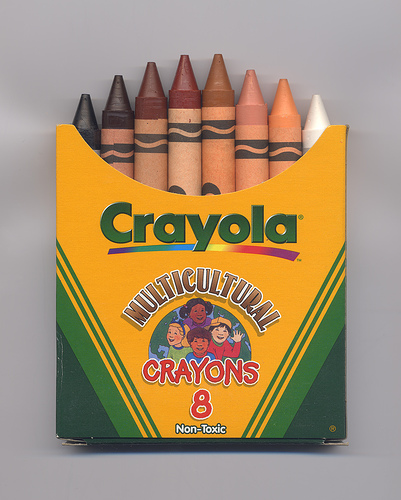




Comments 120
mordicai — August 3, 2008
Considering that "multicultural" is better than buying into a flawed terminology like "race," I'm going to have to say it is a win for the crayons.
Sociological Images » FOR “NORMAL TO DARKER SKIN” — August 6, 2008
[...] make this stuff up. See also this post on white [...]
Sociological Images » WHO IS FACEBOOK? — April 15, 2009
[...] the characteristics we attribute to “person,” unless there are reasons to do otherwise, here, here, and here. tags: color, gender, globalization, race/ethnicity| Permalink| BE [...]
Sociological Images » Using Black as a Neutral Color — May 16, 2009
[...] examples of products listed as “flesh” colored, see this post. tags: color, humor, race/ethnicity| Permalink| You Are What You [...]
Sociological Images » Default Avatars: A Collection — June 19, 2009
[...] while others get imagined as certain kinds of people, visit our posts on the Body Worlds exhibit, “flesh” colored products, Pixar films, gender and clothes, and Plan and Playmobile [...]
Christian is not a Religion » Sociological Images — October 14, 2009
[...] we attribute to “person,” unless there are reasons to do otherwise, here, here, here, and here. 15 Comments Tags: law/crime, prejudice/discrimination, religion, the [...]
Stunning Example of the Neutrality of Whiteness » Sociological Images — November 27, 2009
[...] our post on “flesh-colored” for these examples and more. See also this post on lotion for “normal to darker [...]
The unbearable whiteness of flesh : Contrarian — November 28, 2009
[...] Images collected a gallery of images rooted in the same assumption. The website’s Lisa Wade of Occidental College wrote: Part of [...]
Squoo — December 15, 2009
I'm horrified to think what sort of subconscious message this sends out to people of minority racial groups who are surrounded with this all their lives. Personally, although I am caucasian I've always found so-called 'flesh' tones far too dark for me; even makeup is difficult - plenty of ranges have colours called 'porcelain' or 'ivory' or even 'extra pale' yet somehow they still end up looking like browny-pinky-orange on my skin, and it's amazing how even that can affect the way a person thinks about themselves. Magazine articles I read growing up about makeup/clothes/whatever for 'your colouring' only admitted the existence of very pale skin if it was pink toned 'peaches-and-cream' (to my pink-less yellowy white) and topped with with blonde hair (to my deep dark brown) and I grew up feeling like some ugly abnormality for failing to be the 'right' type of white: either a rosy-cheeked blonde or a brown-eyed tanned brunette. I can only imagine what it must be like to be made to feel that you not only have the 'wrong' shade like me but the 'wrong' colour and the 'wrong' race entirely.
JustRenn — December 15, 2009
@Squoo -- are we related? I have that same super-pale-but-yellowish-not-pinkish skin and brown hair thing going on. Realized today that I am the same color as my off-white carpet ...
I've always been surprised that ALL bandaids aren't the clear kind. Love those.
Women Can Wear Men’s Shirts, but Men Cannot Wear Women’s » Sociological Images — April 15, 2010
[...] racial bias, male neutrality in stick figures (here and here), male-default avatars, flesh-colored products, for normal to darker skin, Michelle Obama’s “flesh-colored” gown. var [...]
Baxter — May 18, 2010
people colors. lol i like that. it sounds like something a little kid would say (a little kid who doesnt know how to be racist yet)
Darnivorous: A Blog by Dariane Nabor » Multicultural Crayons — May 25, 2010
[...] memories overcame me as I was reading a blog (called Sociological Images) via Google Reader about “White Privilege.” The article shows images of “flesh-colored” bandages and crayons, and the complexion is [...]
Anonymous — December 8, 2011
I would argue that the Breathe Right strips use the term "normal" in regards to the sensitivity of skin, rather than color. They also offer a version for sensitive skin: http://www.breatheright.com/products/clear.aspx
Anonymous — December 8, 2011
The "clear" version of nasal strips are apparently formulated for dry/sensitive skin, so I think by "normal" skin they mean it's not dry or oily. Not sure why they make the dry skin version as clear, though.
Anonymous — December 8, 2011
I love the people colors pencils, but EW about the homeschooling sites: "Okay, first of all: Don’t worry. I am not on a diversity kick, despite what you might think." uh, what?
Blix — December 8, 2011
Using "multicultural" is still a far cry from not being racist. People can be completely different in appearance and still be from the same culture. God made us and to claim that humans are anything less than equal is a slap in His face.
Alura_5 — December 8, 2011
Regarding the breathe Right strips - I believe the term 'Normal' was not a color reference, but a skin-oil-content reference. "Normal" skin in cosmetics and health products means your skin is not excessively dry OR oily. Just look at any bottles of make up foundation and regardless of the color of the product, you will find the words, "Normal", "Oily", and "Dry", and even "Combination" on the labels.
Also, it could denote soemthing about the adhesive ebing fine for people who don't react to dyes, and that have "Sensitive" skin, therefore the company has a nother line for people with that needed another adhesive formula, but didn't feel they needed to re-do all their products, just a small portion of them. This is similar to many detergents.
The word 'tan' already referenced a color option, so there would be no need on the packaging for the product's color. It would be redundant and a waste of text on the packaging.
Makenziecj — December 8, 2011
I was shopping for artist's markers in various skin tones the other day, and was startled to discover that one brand labeled its colors things like "peach" and "sand" and "mahogany"- except for that one color, which was called "skin white".
helen — December 8, 2011
The 'normal' on the Breathe Right box refers to skin that is not 'sensitive.'
Resplendence — December 8, 2011
This website is actually ridiculous. Who gives a damn about crayons, plasters and clown wigs? There are bigger issues out there than whether or not Crayola makes a range of "flesh" coloured crayons from light to dark. Get some perspective please!
123isme — December 8, 2011
"Tan strips for normal skin"
Just....wow.....
Mrmister — December 8, 2011
Won't someone please think of the clowns of color? :(
Breeann — December 8, 2011
Oh, so someone else did see the 'normal' thing on the Breathe Right as 'normal skin'. It took me like five minutes to figure out that they meant 'sensitive'. I think its just shoddy wording. Course, tan is just as bad anyways.
Nora Reed — December 8, 2011
Marginally related: Starbucks Skin Scale (warning: TVTropes will eat your life).
Anonymous — December 8, 2011
It's only recently that Crayola renamed that collection "multicultural crayons." When I was little (i.e. 90s) and in school, they were called "my world," which I think they should have stayed with, because it's an unoffensive, accurate term for the collection, which had various shades of brown and tan as well as peaches, blues, reds, etc for mixing and for coloring hair, eyes, etc in addition to skin.
Meredith Palmer — December 8, 2011
and this is why the muppets are blue, red, green, etc. lordy. they've had some issues dealing with hair though, but they're working on it.
Anonymous — December 8, 2011
Normal isn't a reference to the color of the skin, but rather the oiliness (for similar examples, look at lotion, or CoverGirl products that will have "normal" on the packaging of every color of makeup).
It's interesting to see the fact that crayola's "flesh" crayons actually changed color at some point, though.
pduggie — December 8, 2011
what's wrong with multicultural crayons? Multiracial crayons wouldn't have worked, since you could use the crayons for some colors for more than one racial grouping.
If they'd used 'race' in the name, someone would have probably objected about the social construction of race in any case.
Heatherleila — December 9, 2011
The band-aid thing really gets me. I used to work at a pre-school where most of the children were black. And yet, the school had only "flesh" colored band-aids. And little kids are ALWAYS asking for band-aids. I always thought about it when I put these band-aids on their little fingers that were clearly constructed to match someone else´s skin.
A simple solution would have been to purchase thematic band-aids - like animals or neon colors - little kids love that kind of thing. A more complex solution would be to get companies to make different colored band-aids to match a wider spectrum of skin tones.
http://heatherleila3.blogspot.com/2010/06/system-will-be-racist-on-my-behalf.html
Gilbert Pinfold — December 9, 2011
The bias originated on both supply and demand side. That is, early modern consumer goods were invented by white people for white people. Now black people want essentially the same stuff, but evidently it's all still made by white people. So now it's a supply side thing.
Anonymous — December 9, 2011
Is incredible how blind you get when you're neck deep in privilege. Just that color on bandage and bandaids - why? It's not like there's a stated purpose to it, they just automatically pick a color to match a certain brand of white skin when it could have any color or pattern there is.
Katherine — December 9, 2011
Recently in New Zealand we had a general election. The official colour for voting papers for people enrolled on the Maori electoral roll was "buff". They were basically a pale flesh colour. It is pretty funny that noone else sees how inappropriate it is to call Maori voting papers "buff" (when most Maori have darker skin).
Caramel and Cinnamon — December 9, 2011
OMG, I can't believe Pioneer Woman actually had to include this disclaimer in her post "Okay, first of all: Don’t worry. I am not on a diversity kick, despite what you might think."
WHAAA?!
Anonymous — December 9, 2011
I certainly still have a lot to learn about race and my own white privilege, but I do remember even as a young child the flesh-colored (as Caucasian skin only) band-aids bothered me. I figured racism couldn't be over if black people couldn't buy band-aids in their own skin tone. It bums me out that I've never heard a white person mention this before, as it seems like a fairly obvious that there is systemic racism going on here.
Anonymous — December 10, 2011
When I was young, I did not even realize that the "flesh" colored band-aids were supposed to indicate skin color, I just thought they were tan-colored! This idea of "nude" or "flesh" being equivalent to shades found in mostly white people bothers me the most in fashion. There are dresses or blouses with sheer areas with tan fabric underneath to give the appearance of skin. If your skin isn't close to this color, these items just look wrong on you. Of course, what is most problematic is referring to this color as "nude" as if those who aren't this color do not exist. Even with the economic argument made about availability of different skin colored products, there is no reason to call these tones nude or flesh.
Given the fact that most people in the world are not white and growing economic markets in Asia and Latin America, I think there is enough economic incentive to provide more options, especially when it comes to cosmetics. Band-aids certainly are not a luxury item, they can expand their offerings too.
Blenda Lau — December 10, 2011
I think that this article is very interesting, revealing the fact that color preference can be observed even in toys for kids - crayons. I never paid attention to the meaning of "flesh" but now I discover how people favor light peach color than brown color in "flesh". However, the author also depicts that US society is attaining higher equality in various areas. In other words, the development of human society is stepping towards a fairer and more righteous world.
hanspeterfranz — December 14, 2011
that's a very interesting collection...
it reminded me of my time in the kindergarten in Berlin of the mid-80s. we actually called every tone from pink to light brown "hautfarbe" (skin color).
back then the black community was rather small and not "visible", so it wasn't part of our everyday life. I had a lot of classmates from turkey and arabian countries, but very few black girls and boys.
Anonymous — December 19, 2011
Jumbo Pencils has it right by calling it "people colors." I prefer skin colors though. Multicultural is inaccurate as people within a culture an have different skin tones.
Attitudes About Race | Erin V Echols — February 26, 2012
[...] One does not have to look hard to find negative stereotypes (or even “positive stereotypes”) of various racial/ethnic groups in movies,sports, politics, comedy, toys, advertisements, costumes and products. [...]
A Side-eye Critique: The Reading of Frans Verhagen « PLUG — April 5, 2012
[...] privilege is, thus, naturalized while the construct (White Autochtoon Dutchness) itself serves as the unspoken norm. The power and security that flow from White Autochtoon Dutch privilege are hardly value neutral, [...]
Gaycism and The New Normal: The “Hot” Trend This TV Season is Bigotry « In Our Words — September 27, 2012
[...] something about it and then they apologize and never do it again. You know they mean well, and “flesh colored” band-aids prove white privilege is hard to spot sometimes. However, Two Broke Girls is like [...]
Nico Lang: 'Gaycism' and The New Normal: The 'Hot' Trend on TV Is Bigotry | — October 2, 2012
[...] about it and then they apologize and never do it again. You know they mean well, and “flesh colored” band-aids prove white privilege is hard to spot sometimes. However, Two Broke Girls is like [...]
Nico Lang: ‘Gaycism’ and The New Normal: The ‘Hot’ Trend on TV Is Bigotry | Screw Cable — October 2, 2012
[...] about it and then they apologize and never do it again. You know they mean well, and “flesh colored” band-aids prove white privilege is hard to spot sometimes. However, Two Broke Girls is like [...]
Nico Lang: ‘Gaycism’ and The New Normal: The ‘Hot’ Trend on TV Is Bigotry | Screw Cable — October 2, 2012
[...] about it and then they apologize and never do it again. You know they mean well, and “flesh colored” band-aids prove white privilege is hard to spot sometimes. However, Two Broke Girls is like [...]
Nico Lang: ‘Gaycism’ and The New Normal: The ‘Hot’ Trend on TV Is Bigotry | TV Shows Now — October 2, 2012
[...] about it and then they apologize and never do it again. You know they mean well, and “flesh colored” band-aids prove white privilege is hard to spot sometimes. However, Two Broke Girls is like [...]
Huffington Post Article: ‘Gaycism’ and The New Normal: The ‘Hot’ Trend on TV Is Bigotry!!! | Gayblackcanada — October 2, 2012
[...] about it and then they apologize and never do it again. You know they mean well, and “flesh colored” band-aids provewhite privilege is hard to spot sometimes. However, Two Broke Girls is like [...]
Nico Lang: ‘Gaycism’ and The New Normal: The ‘Hot’ Trend on TV Is Bigotry - WatchXonline.com | WatchXonline.com — October 2, 2012
[...] about it and afterwards they apologize and never do it again. You know they meant well, and “flesh colored” band-aids infer white payoff is tough to mark sometimes. However, Two Broke Girls is like [...]
Gaycism And The New Normal: The ‘Hot’ Trend In TV Is Bigotry | Thought Catalog — October 4, 2012
[...] about it and then they apologize and never do it again. You know they mean well, and “flesh colored” band-aids prove white privilege is hard to spot sometimes. However, Two Broke Girls is [...]
Only L<3Ve @ ItMakesMeStronger.com — October 4, 2012
[...] about it and then they apologize and never do it again. You know they mean well, and “flesh colored” band-aids prove white privilege is hard to spot sometimes. However, Two Broke Girls is [...]
Hux Leary McShulgin — September 17, 2013
Wow, never thought about bandages being "racist". I remember the 'Flesh' crayon outrage when I was in kindergarten.
You don't automatically see the bias in these products unless you're non-white, so calling the outrage "petty" or whatever is not your call as a white person. Imagine if the tables were turned. Eventually these small things add up to make you feel alien or abnormal. It's a gradual mind-fuck for non-white people, and I can't imagine how awful it feels. (As a woman, I can spot subtle sexism everywhere. If I were a woman of color, I'd be pissed off ALL the time).
Ed — September 28, 2013
Flesh was and is still a relevant color. It was never intended to be the skin pigmentation color, it was intended to be the color of one's palms. If you look at the palms of every human race on the planet, they are essentially the same color...flesh! People misinterpreted the crayon color to mean skin color and that's where all the problems stem from...misinterpretation. As for the Crayola crayon, it actually started out as "Flesh Tint", got shortened to "Flesh", renamed to "Pink Beige", renamed back to "Flesh" and then finally renamed to "Peach".
A Side-eye Critique: The Reading of Frans Verhagen | Processed Life — November 21, 2013
[…] privilege is, thus, naturalized while the construct (White Autochtoon Dutchness) itself serves as the unspoken norm. The power and security that flow from White Autochtoon Dutch privilege are hardly value neutral, […]
Realizing My White Privilege | Raising Anti-Racist Kids — December 14, 2013
[…] White-Privilege:”Flesh-Colored” […]
Conversations with Cristopher: The Color of Skin | Ethnography.comEthnography.com — December 2, 2015
[…] I wondered if he would see his own skin color as the “normal” skin color. We often see our own skin color as the “normal” skin color, and in the U.S., products often, especially historically, have both covertly and overtly insinuated that white or peach is the “normal” skin color. […]
Настрой и забудь: как установки по умолчанию управляют миром — The Idealist — August 3, 2016
[…] предпочтения. Лейкопластыри и карандаши, призванные совпадать с цветом кожи, долгое время были доступны только в светлом и […]
Daniel McCoy — December 2, 2016
Someone at my work was looking for a white leotard for his daughter, but accidentally phrased the request "white girl's leotard". It caused a lot of joking around at his expense. (He described having a sinking feeling just after he hit "send".)
But I also noticed that if you do a search for "nude leotard", I'm sure you can guess what color they mostly are.
Set It and Forget It: How Default Settings Rule the World — November 30, 2017
[…] also reflect a legacy of attitudes we’re not proud of. The default skin color, in things like “flesh-colored” band-aids and crayons, was long a light tan or peachy color — hardly a reflection of the […]
Sein Maestro — February 7, 2018
WOW thank you for this post! Someone cares about the little things that add up very fast.
Since youth everytime I see "nude" or "flesh tone".. A piece of me shrinks in purpose and importance.
Jet — June 3, 2018
Flesh coloured not skin colour. We are all the same colour below the skin.
Bluemich — September 20, 2018
This sensitivity to skin color is the reason that I refuse to use the word "black" when referring to a person's ethnicity, because I have never seen a "black" person. They are all darker or lighter shades of brown/tan!
Reality Check — December 31, 2018
Jesus. People really need to get over themselves. If you think you’re oppressed because bandages, crayons, etc refer to “flesh color” as being approximately the color of Caucasian skin, then your life must be so awesome that you have to make shit up to get mad at. What is ironically referred to as a “white person problem.”
And incidentally, that comment by Bluemich about being so sensitive about people’s skin color that you never use the word “black” to describe someone, because you’ve never seen a person who is black ... what a crock of shit. When have you seen a white person, who is actually white? I myself am a fleshy-pinkish color. I’ve never seen an actual “white” person, except maybe an albino. It’s just I e never complained about it, because I have better shit to do than get my panties in a bunch about how someone whom I’ve never met refers to my skin color.
Maryna — October 28, 2019
I was taught in business school that if you identify a gap in the market, then this is an opportunity to pounce on it, exploit the opportunity and make money.
Except if you're a person 'of colour', it seems. Then you sit around and bemoan the racist state of the world and complain about the fact that companies with (one would assume) white CEOs and white product developers have not developed band-aids, ballet shoes, etc specifically and especially for you.
Why do we even tolerate such a victim mentality in our day and age?!
The aim of businesses is to make money, not to pander to anyone's likes and dislikes. Where are the black CEOs building factories and business that sell band-aids designed for black people?! Or better yet, for everyone!
While everyone is bemoaning those racist band-aid companies, consider this: if a white CEO were found making money from band-aids designed for people of colour, I'm sure that will be an example of exploitation or cultural appropriation or some other evil concept I can't even conceive of yet - and it will cause yet another outrage. Seriously, nobody is ever going to win here.
American expat in Europe — June 29, 2020
The western society is a white society, we made it -better or worse, with many or not too many defects, that's another debate-, almost everything around us was invented by white people, our cities, buildings, machines, legal systems, political institutions, etc, etc, were created by our white ancestors because they were the majority of the people until capitalism forced people from other countries and races to migration.
So yeah, the "normal" thing in the "white" world is to be white, from a wide variety, sure, from the tanned and brown haired and eyed people from southern Greece to the pale naturally blonde people from Iceland, but certainly most euro-descendants are in the middle of those extremes and most of us share a rater similar skin color with slightly different tonalities. So, yeah, there's a "skin" color for crayons, and in not neurotic white societies, like many in Europe, people use such term without feeling like a criminal. Our protestant anglosaxon mentality of guilt and self-reprehension is a real masochistic perversion that catholic cultures don't suffer that much -I'm talking about cultural heritage, not about practicing any religion; like it or not, we are children of the 16th century-.
So, let's stop flagellating ourselves. If you don't feel comfortable in the western societies, move to somewhere else. I am not going to tell black Africans how they have to name things in THEIR society. If I move there it's me who has to respect their way to see and interpret the world, not the opposite; and of course they must have a black privilege in the land of the black people, it's their land not Euro Americans', Europeans', Asians', Brown Africans', nor anybody else's.
American expat in Europe — June 29, 2020
BTW, I can't agree more about how "interesting" is that substitution of "race" for "culture". Anything more racist that assuming that if your race is "X" then your culture is "X" too and that every racial group belongs to the same culture? If you are black then you surely wear basketball outfit, afro hairstyle, listen hip-hop or jazz, and speak "nigga"; if you are Asian you are the sh*t at math, speak fluent Chinese and hold a black belt in karate at least, if you are white, Hispanic American, Arab, etc, put here the cultural stereotypes you like better...
I had a black professor who was a specialist in Spanish Golden Age literature and drama, he also sang in an amateur Renaissance music choir centered in Andalusian School of Polyphony; I wonder how he'd feel... Or what about white chess players like Bobby Fischerm playing an Indian/Arab game... Or all those non euro-descendants scientists that use the scientific method, created in Greek and Latin Europe. They all are totally out of their "cultural" space since according to Crayola they should be tied forever to their race's original culture, it seems...
Unbelievable!
That “Flesh” Colored Crayon and Other Fake Nudes - Blak-X — January 19, 2022
[…] Related article[https://thesocietypages.org/socimages/2011/12/08/white-privilege/] […]
Painter — March 4, 2022
Painting developed in Europe, where people tend to be white, it was practically non-existent anywhere else, therefore the term flesh color was logically associated with the tones of European skin. This is one of the unfortunately many samples today of trying to find wrong where there wasn't. Ok, we live in a different world today, the term has been eliminated practically everywhere, so why don't we move on? Or is it to easy a bait for naive onlookers
Set It And Forget It: How Default Settings Rule The World - The Beachwood Reporter — October 10, 2022
[…] a legacy of attitudes we’re not proud of. The default skin color, in things like “flesh-colored” band-aids and crayons, was long a light tan or peachy color – hardly a reflection of […]
Common sense — October 20, 2023
What a ridiculous load of shit this post is. You're searching for things to be offended about. So much so, that you're reaching back to products and ads from the early 1950s. And it would have taken a fraction of a second to realize that Breathe Right strips "normal" descriptor is a reference to skin sensitivity, not color. If it were a measure of feelings, I'd highly suggest the sensitive ones for the "author" of this post. Get a life, daffodil.